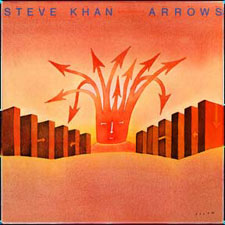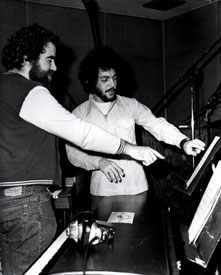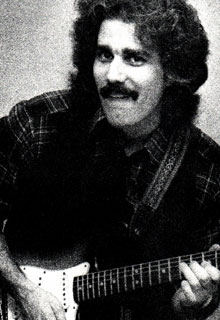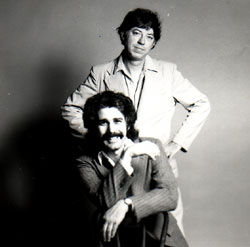Steve Khan's lead sheet:
"Calling"(Khan)
Ever since Khan's Korner was first launched some years ago, I've been meaning to present the beautiful ballad, "Calling" which appeared on the "ARROWS" recording from 1979. Perhaps I've been avoiding it because I knew that I would have to rewrite the lead sheet? More than likely it was just the fact that I've been trying to present more of the recent material whenever possible. And now, here we are and, in back to back months, I am bringing you back to back ballads!!! However, in supporting roles, the performances of Don Grolnick and Steve Gadd are so spectacular that I couldn't wait any longer to present this one! The tune serves as a harmonically sophisticated, but off-handed, tribute to Jimi Hendrix, as my Fender Strat, with its tremolo arm in full display, is my melodic voice. David Sanborn's alto sax provides the contrasting voice, and his playing is characteristically expressive here. However, in supporting roles, the performances of Don Grolnick and Steve Gadd are so spectacular that I couldn't wait any longer to present this one! The tune serves as a harmonically sophisticated, but off-handed, tribute to Jimi Hendrix, as my Fender Strat, with its tremolo arm in full display, is my melodic voice. David Sanborn's alto sax provides the contrasting voice, and his playing is characteristically expressive here.
As I might have stated in the previous presentation, this ballad just seemed to flow, a special marriage between melody and harmony. As easy as that was to create, the tune travels between three very distinct rhythmic feels and all are negotiated with flawless grace by the aforementioned Steve Gadd, Don Grolnick, and Will Lee. The [A] sections receive a Jazz ballad treatment which features Steve's wonderful brush work, and Don's nonpareil comping. I have said this before, and I duty bound to say it again. Having Don Grolnick accompany you is a musician's greatest gift and pleasure. If you study this track, listen, and listen carefully to just how gracefully and romantically Don treats each [A] section. The last 4 bars of [A] are treated as a 'light' R&B feel, and the section is a precursor to what will appear later at [C]. When the band hits the [B] section we go to double-time, with the quarter-note equal to the half-note. I might describe this feel as a 'light samba.' Coming out of this section we move into [C] which takes us back into 4/4 and a more R&B related feel. [A3] sees us reprise the main melody, and, it is back to the more basic Jazz ballad feel. This brings us to [D] and the solo section which is played over the identical feel and changes as letter [B]. After a Cue figure, we restate [A4] and finally employ a Fade at [E] which is intended to give some improvisational space to David Sanborn. This brings us to [D] and the solo section which is played over the identical feel and changes as letter [B]. After a Cue figure, we restate [A4] and finally employ a Fade at [E] which is intended to give some improvisational space to David Sanborn.
As I have done on many of the revised lead sheets from the Columbia years, I have updated them by actually transcribing some of Will Lee's bass parts. Although I think that it might be instructive for you to have seen what I had originally written for him, and to then compare and contrast that with what he actually played. I have decided that it was best to try and present what feels best based upon a great bass player's most musical instincts. If one of you decides to play this tune or others with your own group, even a rehearsal-oriented group, it will be much easier to pass out these lead sheets and get more immediate results. And that is important to me as well. During all the [A] sections, I only had whole notes written for the bass. And, in truth, that would certainly have worked, but that doesn't take into account the human element, the element of conversational playing. And Will was simply listening and reacting to what was around him melodically, harmonically and rhythmically. As always, his playing is rich with personality, warmth and even humor.
If we were to address the theoretical approach to an improvisation over two maj7th chords a m3rd apart, in this case: Ebmaj7 for 4 bars and Cmaj7 for 4 bars, there are any number of options one might choose to employ. Often times players see maj7th chords before them and can't get excited about it, because they can't 'see' the 'blues' in there, anywhere. But, if one employs certain simple pentatonic approaches, everything becomes possible. For example, over the Ebmaj7 area, I would use G minor pentatonic[G, Bb, C, D, F], because it gives you all the basic 'color tones': maj7, 9th and 6th/13th. Using the same type of thinking, one could use the E minor pentatonic[E, G, A, B, D] over the Cmaj7 chord. Both of these pentatonic options are built upon the 3rd degree of the chord scale[Major or Lydian] for these harmonies. If one wanted to employ the Lydian sounds, the best choice is always the minor pentatonic build upon the major 7th degree. So, over Ebmaj7, that would be D minor pentatonic[D, F, G , A, C], and you can see that it provides you with ALL the color tones, including the #4. Over Cmaj7, you would use the B minor pentatonic[B, D, E, F#, A]. As you will, my improvisation was primarily derived from the earlier option offered. The modal options are pretty simple. For the Ebmaj7, you could use Eb Major/Ionian or Eb Lydian[Eb, F, G, Ab/A, Bb, C, D]. And for Cmaj7, you could use C Major/Ionian or C Lydian[C, D, E, F/F#, G, A, B]. For continuity, you would want to use common tones, and I have highlighted those tones for you. In general, I would caution you against using the Root on maj7th chords, and also the natural 4th(the suspension). But, if you try jamming over a progression like this, force yourself to use those scale degrees, and you can best make your own assessment as to what sounds good or not. The minor pentatonic which contains the root is built upon the 6th degree of the major scale. When well used, it tends to give more of an R&B feel to your improvisation. Great players like George Benson and Larry Carlton often employ this device and use it beautifully. There is certainly nothing wrong with that. But the accompaniment has to allow room for those tones to speak well. In this improvisation of mine, there is very little linear chromaticism at all, and this is probably a fair representation of where I found myself during those years. But, mercifully the "Fusion" era was soon to come to an end, brought to a screeching halt by various insidious forces!!! Using the same type of thinking, one could use the E minor pentatonic[E, G, A, B, D] over the Cmaj7 chord. Both of these pentatonic options are built upon the 3rd degree of the chord scale[Major or Lydian] for these harmonies. If one wanted to employ the Lydian sounds, the best choice is always the minor pentatonic build upon the major 7th degree. So, over Ebmaj7, that would be D minor pentatonic[D, F, G , A, C], and you can see that it provides you with ALL the color tones, including the #4. Over Cmaj7, you would use the B minor pentatonic[B, D, E, F#, A]. As you will, my improvisation was primarily derived from the earlier option offered. The modal options are pretty simple. For the Ebmaj7, you could use Eb Major/Ionian or Eb Lydian[Eb, F, G, Ab/A, Bb, C, D]. And for Cmaj7, you could use C Major/Ionian or C Lydian[C, D, E, F/F#, G, A, B]. For continuity, you would want to use common tones, and I have highlighted those tones for you. In general, I would caution you against using the Root on maj7th chords, and also the natural 4th(the suspension). But, if you try jamming over a progression like this, force yourself to use those scale degrees, and you can best make your own assessment as to what sounds good or not. The minor pentatonic which contains the root is built upon the 6th degree of the major scale. When well used, it tends to give more of an R&B feel to your improvisation. Great players like George Benson and Larry Carlton often employ this device and use it beautifully. There is certainly nothing wrong with that. But the accompaniment has to allow room for those tones to speak well. In this improvisation of mine, there is very little linear chromaticism at all, and this is probably a fair representation of where I found myself during those years. But, mercifully the "Fusion" era was soon to come to an end, brought to a screeching halt by various insidious forces!!!
If I might, I would like to offer a couple small guitar-oriented notes. At [C], and I believe that I overdubbed this part, I used that 'in-between' pick-up sound. If you have a 5-position pick-up selector switch, it is the 4th one away from you. It puts to use the sound that exists between the middle pick-up and the bridge pick-up. Everyone who has ever played a Strat knows this sound because it is so particular to that brand and that instrument. It is very funky, to be sure. So, this was played totally without any effects. Obviously, the sound I used for the the opening [A] section, and the solo section, was enhanced with delays and reverb, all used in conjunction with a bit of tube distortion. And, of course, the liberal usage, perhaps too much, of the tremolo arm. I think that, if I were ever to re-cut this tune, I would attempt to get a sound more like what I achieved on "Dr. Slump" from the "EYEWITNESS" recording. That sound is far better suited to projecting something romantic, yet forceful. Everyone who has ever played a Strat knows this sound because it is so particular to that brand and that instrument. It is very funky, to be sure. So, this was played totally without any effects. Obviously, the sound I used for the the opening [A] section, and the solo section, was enhanced with delays and reverb, all used in conjunction with a bit of tube distortion. And, of course, the liberal usage, perhaps too much, of the tremolo arm. I think that, if I were ever to re-cut this tune, I would attempt to get a sound more like what I achieved on "Dr. Slump" from the "EYEWITNESS" recording. That sound is far better suited to projecting something romantic, yet forceful.
One of the nicest aspects of working on "ARROWS" was having a good friend and great engineer, Elliot Scheiner as a co-producer. Prior to this recording, we had known each other for years around the studios of New York and I had watched him gain greater and greater recognition via his work with Steely Dan. Of course, today Elliot is a most sought after, multi-Grammy Award winning Engineer/Producer, which includes some great work with The Eagles! Though, at times, we had differing opinions about what might sound the most "Hi-fi" on this recording, I think that the sound for this track and others holds-up rather well.
[Photo of Don Grolnick and Steve Gadd by Chuck Stewart from 1976
Photo of Steve and Strat, by Richard Laird, taken in 1980
Photo of Steve and Jean-Michel Folon by Jim Houghton from 1979]
|

